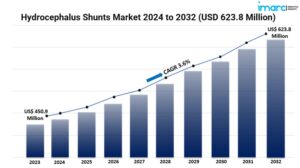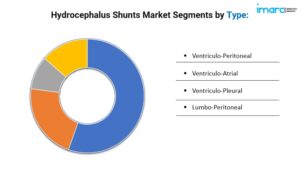
The latest report by IMARC Group, titled “Hydrocephalus Shunts Market Report by Type (Ventriculo-Peritoneal, Ventriculo-Atrial, Ventriculo-Pleural, Lumbo-Peritoneal), Product Type (Hydrocephalus Valves, Hydrocephalus Catheters), Age Group (Infants, Children, Adults), End User (Hospitals, Ambulatory Surgical Centers), and Region 2024-2032”, offers a comprehensive analysis of the industry, which comprises insights on the market. The global hydrocephalus shunts market size reached US$ 450.9 Million in 2023. Looking forward, IMARC Group expects the market to reach US$ 623.8 Million by 2032, exhibiting a growth rate (CAGR) of 3.6% during 2024-2032.
Hydrocephalus Shunts Industry Trends and Drivers:
- Increasing prevalence of hydrocephalus and related neurological disorders:
One of the primary factors driving the hydrocephalus shunts market is the rising prevalence of hydrocephalus and other neurological disorders worldwide. Hydrocephalus, characterized by the abnormal accumulation of cerebrospinal fluid (CSF) in the ventricles of the brain, affects individuals of all ages, from infants to the elderly. The condition can result from various causes, including congenital abnormalities, infections, brain injuries, and complications from surgery. In the aging population, conditions such as Alzheimer’s disease, Parkinson’s disease, and other neurodegenerative disorders increase the risk of developing hydrocephalus, particularly normal pressure hydrocephalus (NPH). The increasing prevalence of hydrocephalus has led to a greater demand for effective treatment options, including hydrocephalus shunts. Shunts are devices surgically implanted to divert excess CSF from the brain to other parts of the body, where it can be absorbed. The growth of the elderly population, particularly in developed regions, is a significant contributor to the rising incidence of hydrocephalus, leading to a corresponding increase in the demand for hydrocephalus shunts. Moreover, improved diagnostic techniques and heightened awareness among healthcare professionals and the public have contributed to earlier detection and treatment of hydrocephalus, further driving the market.
- Advancements in shunt technology and product development:
Technological advancements and product innovation in hydrocephalus shunts are significant factors fueling market growth. Traditionally, hydrocephalus shunts have faced several challenges, including mechanical failures, infections, over-drainage, and under-drainage of cerebrospinal fluid. However, recent advancements in shunt technology have led to the development of more reliable and durable shunts, reducing the frequency of complications and the need for revision surgeries. Newer shunt models, such as programmable shunts, allow for non-invasive adjustments of the pressure settings of valves, offering a tailored approach to managing CSF flow according to the specific needs of the patients. Additionally, anti-siphon devices have been developed to prevent over-drainage of CSF, a common issue associated with traditional shunt systems. These technological improvements enhance patient outcomes and reduce healthcare costs by minimizing complications, which in turn boosts market demand.
- Rising healthcare expenditure and improved access to medical care:
Increasing healthcare expenditure and enhanced access to medical care, especially in emerging economies, are also crucial factors driving the hydrocephalus shunts market. Governments and private healthcare providers are investing more in healthcare infrastructure, improving the availability of advanced medical devices and treatments for neurological conditions, including hydrocephalus. This trend is particularly notable in countries with rapidly growing economies, such as India, China, and Brazil, where expanding middle-class populations are demanding better healthcare services. Moreover, there is a growing emphasis on reducing the economic burden associated with neurological disorders. Hydrocephalus, if left untreated, can result in significant healthcare costs due to repeated hospitalizations, long-term care needs, and loss of productivity. By investing in early and effective treatment options such as shunt systems, healthcare systems can reduce these costs and improve patient quality of life. This has led to an increased adoption of hydrocephalus shunts in both developed and developing regions.
For an in-depth analysis, you can request a sample copy of the report: https://www.imarcgroup.com/hydrocephalus-shunts-market/requestsample
Competitive Landscape:
The competitive landscape of the market has been studied in the report with detailed profiles of the key players operating in the market.
- Argi Group
- Braun Melsungen AG
- Christoph Miethke GmbH & Co. KG
- Surgiwear Ltd.
- HLL Lifecare Limited
- Integra LifeSciences
- Kaneka Medix Corporation (Kaneka Corporation)
- Medtronic Plc
- Natus Medical Incorporated
- Sophysa
- Spiegelberg GmbH & Co. KG (SHS Medizintechnik Holding GmbH)
- TKB Corporation
Hydrocephalus Shunts Market Report Segmentation:
Breakup By Type:
- Ventriculo-Peritoneal
- Ventriculo-Atrial
- Ventriculo-Pleural
- Lumbo-Peritoneal

Ventriculo-peritoneal dominates the market as they are the most commonly used shunt system due to their effectiveness, relative safety, and suitability for treating various forms of hydrocephalus.
Breakup By Product Type:
- Hydrocephalus Valves
- Adjustable Pressure Valves
- Fix Pressure Valves
- Hydrocephalus Catheters
hydrocephalus valves hold the maximum number of shares as they are a critical component of shunt systems, essential for regulating cerebrospinal fluid flow and pressure, and thus play a central role in managing hydrocephalus.
Breakup By Age Group:
- Infants
- Children
- Adults
Children represent the largest segment as hydrocephalus is frequently diagnosed in infants and young children due to congenital conditions and developmental issues.
Breakup By End User:
- Hospitals
- Ambulatory Surgical Centers
Hospitals dominate the market as they are the primary setting for surgical procedures, including shunt implantation and management, offering comprehensive care and access to specialized medical teams.
Breakup By Region:
- North America (United States, Canada)
- Asia Pacific (China, Japan, India, South Korea, Australia, Indonesia, Others)
- Europe (Germany, France, United Kingdom, Italy, Spain, Russia, Others)
- Latin America (Brazil, Mexico, Others)
- Middle East and Africa
North America holds the leading position owing to a large market for hydrocephalus shunts driven by its advanced healthcare infrastructure, high prevalence of neurological disorders, and significant investment in medical research and development.
Ask Analyst for Customization: https://www.imarcgroup.com/request?type=report&id=5226&flag=C
If you require any specific information that is not covered currently within the scope of the report, we will provide the same as a part of the customization.
About Us:
IMARC Group is a global management consulting firm that helps the world’s most ambitious changemakers to create a lasting impact. The company provides a comprehensive suite of market entry and expansion services. IMARC offerings include a thorough market assessment, feasibility studies, company incorporation assistance, factory setup support, regulatory approvals and licensing navigation, branding, marketing and sales strategies, competitive landscape, and benchmarking analyses, pricing and cost research, and procurement research.
Contact Us:
IMARC Group
134 N 4th St. Brooklyn, NY 11249, USA
Email: sales@imarcgroup.com
Tel No:(D) +91 120 433 0800
United States: +1-631-791-1145

